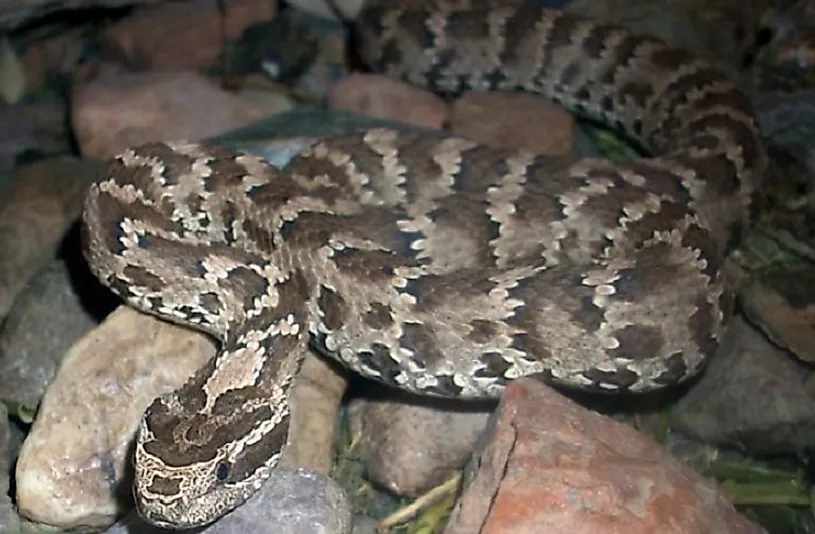Native Reptiles Of Mongolia

Mongolia is a landlocked country in Northern Asia, situated between China to the south and Russia to the north. Mongolia's native lizards and snakes are well suited to its arid deserts and steppe ecosystems. These reptiles are also in the neighboring countries like China. The species have stable populations and are hardly threatened probably due to the sparse human habitation. There are many lizards, snakes, vipers, adders, and geckos in the country. For example, the adder snake is very common in the country inhabiting areas that can accommodate their basking, foraging, and hibernation behavior. The Viviparous Lizard is a unique kind of reptile because it gives birth to live young, unlike most other lizards that lay eggs. Another native reptile of Mongolia is variegated Toadhead Agama, which is found in areas with scanty vegetation. The Halys Pit Viper is a reptile endemic to Mongolia.
Adder (Vipera berus)
The Adder is a venomous snake native to Mongolia and other countries in East Asia and Western Europe. The snake is not aggressive, but it bites when disturbed or alarmed. It loves to bask, forage, and hibernate. As such it is found in habitats like chalky downs, moors, rocky hillsides, and meadows, edges of woods, rough commons, and sunny glades.Sometimes it ventures into wetlands that have dry grounds, so it is found along rivers, ponds, and lakes.An adult usually grows to about 60 centimeters from head to tail. An adder’s head is relatively large with the sides vertical and almost flat. The snout is raised into a small ridge. The snake feeds on lizards, birds, amphibians, and small mammals and in other cases insects, worms, and spiders. The species is ovoviviparous. A female adder breeds after two or three years, with litters born in either late summer or early autumn. The young ones stay with the mother for a few days.
Viviparous Lizard (Zootoca vivipara)
The Viviparous lizard is the only species in the Genus Zootoca. Unlike most lizards, Zootoca vivipara is viviparous, meaning that it gives birth to live offspring. The species is typically brown, but there are other black and olive brown members. Females have dark bands on their flanks running to the middle of the back. Most males have a dark coloration on their undersides. The bottoms of most male lizards are usually brightly colored yellow, orange, and in rare occasions red. The female species has paler or whitish underparts. Both sexes have white or blue throats. Viviparous lizard prefers to live in altitudes of 3,000 meters where it is damp. Its natural habitats are near water like in meadows, swamps, brooks, moist forests, and rice fields. It can also occur on lowland environments in open woodlands, moorland, heath lands, rocks, dunes, fens, hedgerows, gardens, and roadsides. It is a ground species, but it can climb logs, rock, and low-growing plants. Zootoca vivipara typically feeds on invertebrates like small insects. It mates in April or May where a male takes a female in its jaws before mating. If the female snake bites fiercely, it is an indication that she is not interested. The gestation period is usually three months.
Variegated Toadhead Agama (Phrynocephalus versicolor)
The Variegated Toad-Head Agama is an agamid lizard species native to the deserts of Mongolia. This lizard grows to 13 centimeters in length. It has a big and rounded head with a blunt snout with visible nostrils. The large scales along the spine are smooth and not ribbed. Dorsal scales are usually thick and raised at the rear margin. Variegated toad head Agama has a long and tapering tail, with a flat base. The lizard is found in canyons, sand dunes, plains, and slopes with scrubby vegetation. It prefers habitats of altitudes more than 10,500 feet. The lizard hibernates in winters and burrows in summer to escape cold nights or scorching heat of midday. The burrow has a single entrance, will typically not be branched, and usually ends in an underground chamber. Its diet comprises of small invertebrates like flies, ants, ground beetles, grasshoppers. A mature female lays clutches of five pink or white-tinged eggs in the rainy season. Incubation lasts for about 30 days after which 5-centimeter-long young ones hatch. Maturity is reached when they attain a length of 9 centimeters and longer. The species population is stable. There are no particular threats facing these lizards' populations.
Halys Pit Viper (Gloydius halys)
The Halys Pit Viper stretches its habitat range across much of Asia, from Mongolia and south to China, and then east towards the Ural Mountains and north into Russia. It usually grows to an adult length of around 59 centimeters. It has a stout body where the snout is raised slightly. The undersides are grayish, reddish, yellowish, or pale brown with large dark crossbars or spots. On the ventral side it has a generally whitish coloration that is speckled with brown or gray.
Habitats of Mongolian Reptiles
Despite its generally dry climate, Mongolia has a variety of different habitats. These include grasslands, humid scrub-lands, open woodlands, peat bogs, meadows, hedgerows, woodland edges, stream edges, rural gardens, and rivers. These ecosystems provide homes for Mongolia's varied reptiles and other forms of wildlife.
Native Reptiles Of Mongolia
| Native Reptiles of Mongolia | Scientific Name |
|---|---|
| Adder | Vipera berus |
| Halys Pit Viper | Gloydius halys |
| Sand Lizard | Lacerta agilis |
| Yangihissar Gecko | Cyrtopodion elongatus |
| Manchurian Black Racer | Elaphe schrenckii |
| Tartar Sand Boa | Eryx tataricus |
| Variegated Toadhead Agama | Phrynocephalus versicolor |
| Viviparous Lizard | Zootoca vivipara |
| European Grass Snake | Natrix natrix |











